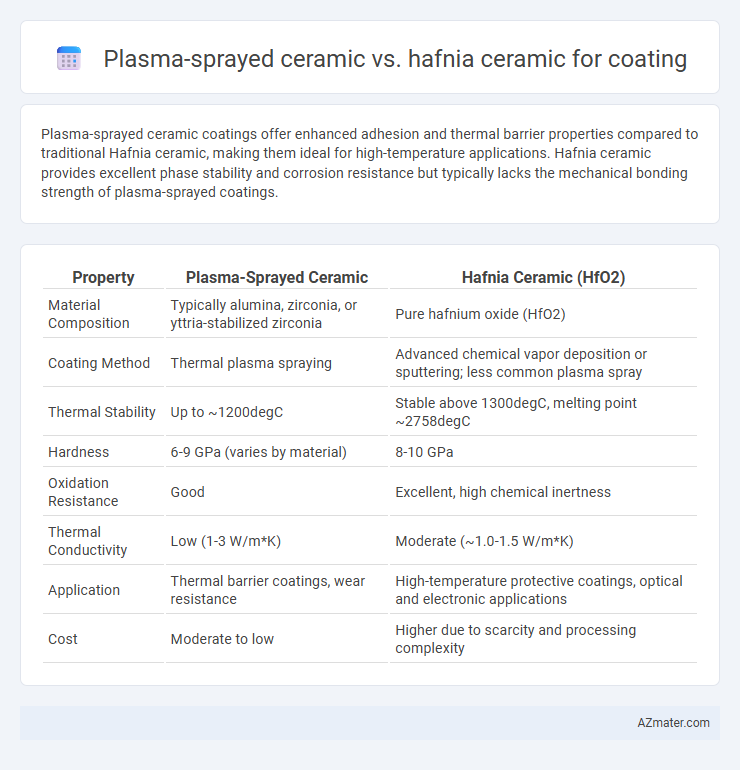Plasma-sprayed ceramic coatings offer enhanced adhesion and thermal barrier properties compared to traditional Hafnia ceramic, making them ideal for high-temperature applications. Hafnia ceramic provides excellent phase stability and corrosion resistance but typically lacks the mechanical bonding strength of plasma-sprayed coatings.
Table of Comparison
| Property | Plasma-Sprayed Ceramic | Hafnia Ceramic (HfO2) |
|---|---|---|
| Material Composition | Typically alumina, zirconia, or yttria-stabilized zirconia | Pure hafnium oxide (HfO2) |
| Coating Method | Thermal plasma spraying | Advanced chemical vapor deposition or sputtering; less common plasma spray |
| Thermal Stability | Up to ~1200degC | Stable above 1300degC, melting point ~2758degC |
| Hardness | 6-9 GPa (varies by material) | 8-10 GPa |
| Oxidation Resistance | Good | Excellent, high chemical inertness |
| Thermal Conductivity | Low (1-3 W/m*K) | Moderate (~1.0-1.5 W/m*K) |
| Application | Thermal barrier coatings, wear resistance | High-temperature protective coatings, optical and electronic applications |
| Cost | Moderate to low | Higher due to scarcity and processing complexity |
Introduction to Thermal Barrier Coatings
Thermal barrier coatings (TBCs) are critical for protecting components in high-temperature environments, with plasma-sprayed ceramics and hafnia ceramics being prominent materials used. Plasma-sprayed ceramic coatings, typically composed of yttria-stabilized zirconia (YSZ), offer excellent thermal insulation and resistance to thermal shock due to their porous microstructure. Hafnia ceramics provide superior phase stability and higher temperature tolerance beyond 1400degC, making them ideal for advanced thermal barrier applications in gas turbines and aerospace engines.
Overview of Plasma-Sprayed Ceramic Coatings
Plasma-sprayed ceramic coatings provide a dense, highly adherent layer that enhances surface hardness and thermal resistance, making them ideal for protecting components in high-temperature environments. This technique involves melting ceramic powders like alumina or zirconia and propelling them onto substrates, resulting in coatings with superior wear and corrosion resistance. Compared to Hafnia ceramic coatings, plasma spraying offers more versatility in thickness and microstructure control, enabling tailored properties for aerospace, automotive, and industrial applications.
Understanding Hafnia Ceramic Coatings
Hafnia ceramic coatings exhibit superior thermal stability and corrosion resistance compared to traditional plasma-sprayed ceramic coatings, making them ideal for high-temperature applications. The chemical inertness and high melting point of hafnium dioxide allow these coatings to maintain structural integrity under harsh environments. Advanced deposition techniques enhance the adhesion and uniformity of hafnia ceramic layers, resulting in improved wear resistance and extended component lifespan.
Material Properties Comparison
Plasma-sprayed ceramic coatings typically exhibit a high degree of porosity and variable microstructure, which can affect thermal insulation and mechanical strength compared to Hafnia ceramic coatings known for their exceptional thermal stability and low thermal conductivity. Hafnia ceramics provide superior resistance to high-temperature oxidation and have higher phase stability, making them ideal for extreme thermal barrier applications. In contrast, plasma-sprayed ceramics are more adaptable to complex geometries but may require post-processing to enhance durability and reduce defects.
Thermal Stability and Heat Resistance
Plasma-sprayed ceramic coatings exhibit excellent thermal stability, maintaining structural integrity at temperatures up to 1200degC, making them suitable for high-temperature applications. Hafnia ceramic coatings offer superior heat resistance, withstanding temperatures exceeding 1500degC due to their high melting point and low thermal conductivity. Both materials provide effective thermal barrier properties, but Hafnia's enhanced phase stability under thermal cycling improves longevity in extreme heat environments.
Oxidation and Corrosion Resistance
Plasma-sprayed ceramic coatings typically exhibit excellent oxidation resistance due to their dense microstructure and high thermal stability, making them ideal for high-temperature environments. Hafnia ceramic coatings provide superior corrosion resistance, especially against aggressive chemical agents, due to their inherent chemical inertness and stability under oxidative conditions. When comparing both, Hafnia ceramics offer enhanced durability in corrosive atmospheres, while plasma-sprayed ceramics excel in thermal oxidation protection.
Mechanical Strength and Durability
Plasma-sprayed ceramic coatings exhibit enhanced mechanical strength due to their dense microstructure and strong adhesion to substrates, making them ideal for wear-resistant applications. Hafnia ceramic coatings, known for their exceptional thermal stability and high fracture toughness, provide superior durability in high-temperature environments. Comparing both, plasma-sprayed ceramics offer better impact resistance, while Hafnia ceramics excel in maintaining structural integrity under thermal cycling conditions.
Cost and Manufacturing Considerations
Plasma-sprayed ceramic coatings typically offer lower manufacturing costs due to established spray equipment and faster application times compared to Hafnia (HfO2) ceramics, which require more specialized handling and higher purity feedstock. Hafnia ceramics provide superior thermal stability and erosion resistance but involve higher expenses in raw materials and processing complexity, impacting overall cost-effectiveness. Optimizing coating selection depends on balancing performance requirements with manufacturing capabilities and budget constraints.
Industry Applications and Use Cases
Plasma-sprayed ceramic coatings offer superior thermal barrier properties and wear resistance, making them ideal for aerospace turbine blades and automotive exhaust systems where high-temperature stability is crucial. Hafnia (HfO2) ceramic coatings excel in corrosion resistance and high dielectric strength, suited for electronics, optical devices, and advanced semiconductor manufacturing. Both materials serve critical roles in industries demanding durability and heat protection, with plasma-sprayed ceramics favored for mechanical wear applications and hafnia ceramics preferred in chemical and electronic environments.
Conclusion: Choosing the Optimal Ceramic Coating
Plasma-sprayed ceramics offer excellent bond strength and cost-effectiveness for thermal barrier coatings, making them suitable for high-temperature industrial applications. Hafnia ceramics provide superior thermal stability and resistance to phase transformation up to 1800degC, ideal for aerospace and advanced turbine components. Selecting the optimal ceramic coating depends on balancing operational temperature requirements, mechanical durability, and budget constraints.

Infographic: Plasma-sprayed ceramic vs Hafnia ceramic for Coating
 azmater.com
azmater.com